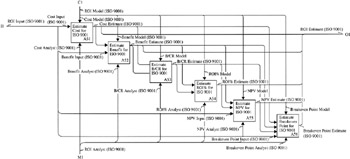11.5 ISO 9001 NPV Methodology
The return on investment (ROI) methodology for ISO 9001 is a procedure to measure, quantify, and analyze its economic value. ISO 9001 is a set of requirements for quality management systems which must be met by firms within the European Union. ROI is the amount of money gained , returned, or earned above the resources spent on ISO 9001. Its ROI methodology is a six-part process that consists of estimating costs, benefits, benefit/cost ratio (B/CR), ROI%, net present value (NPV), and breakeven point. The ROI methodology for ISO 9001 has unique elements for estimating costs, benefits, and B/CR. Its cost and benefit methodologies are complex, although its B/CR, ROI%, NPV, and breakeven point methodologies are simple. Key elements include the process and total life cycle cost models, which are used to estimate the costs and benefits of using ISO 9001. (Much of the data are in the form of opinion surveys, and data are difficult to find.) Figure 53 illustrates the ROI methodology for ISO 9001.

Figure 53: ROI Methodology for ISO 9001
11.1 ISO 9001 Cost Methodology
The cost methodology for ISO 9001 is a procedure to measure, quantify, and analyze the amount of money spent. ISO 9001 incurs cost to develop processes, resulting in higher productivity and lower maintenance. Cost is the economic consequence of using ISO 9001 to create a new and improved software process. Its cost methodology is a seven-part process that consists of estimating process, product, preparation, audit, software, test, and maintenance costs. The cost methodology for ISO 9001 has unique elements for estimating process costs. Key elements include the process, assessment, software development, test, and maintenance cost models. These are used to approximate the costs of software development and maintenance, in conjunction with ISO 9001. The process and product cost model is based on a bottom-up approach to cost estimation. There are some top-down parametric cost models which are viewed as less accurate. Figure 54 illustrates the cost methodology for ISO 9001.

Figure 54: Cost Methodology for ISO 9001
Estimate process cost for ISO 9001: The objective of this activity is to estimate the cost of developing policies, quality manuals, and procedures for ISO 9001. The substeps include: estimate policy cost for ISO 9001, estimate quality manual cost for ISO 9001, estimate procedure cost for ISO 9001, and estimate policy, quality manual, and procedure cost for ISO 9001.
Estimate product cost for ISO 9001: The objective of this activity is to estimate the cost of developing plans and records for ISO 9001. The substeps include: estimate plan cost for ISO 9001, estimate record cost for ISO 9001, and estimate plan and record cost for ISO 9001.
Estimate preparation cost for ISO 9001: The objective of this activity is to estimate the cost of indoctrination, response conditioning, and mock audits for ISO 9001. The substeps include: estimate indoctrination cost for ISO 9001, estimate response-conditioning cost for ISO 9001, estimate mock audit cost for ISO 9001, and estimate indoctrination, response-conditioning, and mock audit cost for ISO 9001.
Estimate audit cost for ISO 9001: The objective of this activity is to estimate the cost of audit planning, audit preparation, audit meetings, and audit follow-up for ISO 9001. The substeps include: estimate audit planning cost for ISO 9001, estimate audit preparation cost for ISO 9001, estimate audit meeting cost for ISO 9001, estimate audit follow-up cost for ISO 9001, and estimate audit planning, preparation, meeting, and follow-up cost for ISO 9001.
Estimate software cost (baseline) for ISO 9001: The objective of this activity is to estimate the costs of software analysis, design, and implementation. The substeps include: estimate software cost (Boehm) for ISO 9001, estimate software cost (Walston/Felix) for ISO 9001, estimate software cost (Bailey/Basili) for ISO 9001, estimate software cost (Doty) for ISO 9001, and estimate software cost (average) for ISO 9001.
In this case, the outputs of the software cost models by Boehm, Walston/Felix, Bailey/Basili, and Doty were averaged together. This was done as sort of a Delphi method to arrive at an average software cost. The reader is free to substitute contemporary cost models, such as COCOMO II, PRICE-S , SLIM , Knowledge Plan , or any others, in order to accurately estimate software costs. The formulas for these models are illustrated in Chapter 5.
Estimate test cost for ISO 9001: The objective of this activity to estimate the cost of software testing based on estimated starting defect populations. The substeps include: estimate post-test defects for ISO 9001 and estimate test cost ( projected ) for ISO 9001.
Estimate maintenance cost for ISO 9001: The objective of this activity is to estimate the cost of software maintenance based on defects escaping the software testing process. The substeps include: estimate total life cycle cost for ISO 9001 and estimate maintenance cost (projected) for ISO 9001.
EAN: 2147483647
Pages: 145